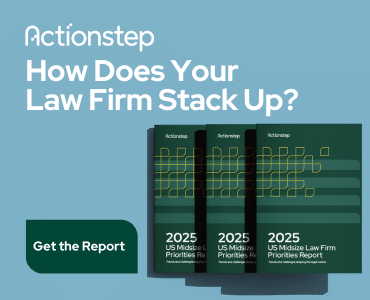Ari Kaplan speaks with Geoffrey Vance, a litigation partner with Perkins Coie and chair of the firm’s E-Discovery Services and Strategy Group, and Ross Guberman, CEO of LawCatch. Law Catch is the developer of BriefCatch, a software platform designed to elevate legal writing, which has recently introduced new generative AI features.

Ari Kaplan: Tell us about your background and your practice at Perkins Coie.
Geoffrey Vance: I’m proud to say I’m a Navy veteran. I served in Desert Shield and Desert Storm when I was in college. I returned to college, finished law school and then clerked for a federal district judge in Chicago. I have worked at several law firms and currently serve as a partner in the commercial litigation practice group, leading the E-Discovery Services and Strategy group, at Perkins Coie in Chicago. In that capacity, I litigate cases around the country in state and federal courts for a diverse set of clients, and I help run our e-discovery services provider.
You practiced for several years before pursuing a career focused on legal writing and development and BriefCatch, Ross. How is technology changing the way lawyers advocate on behalf of their clients?
Ross Guberman: Thank you for your service, Geof. We are living through an exciting time when it comes to how lawyers are leveraging technology to better advocate for their clients. We are seeing a meeting of the minds between law firm clients and the partners who manage their projects. They are finding the right mix between the various tools that are available to them to be more efficient and effective while being careful about data security.
You clerked in the Northern District of Illinois. Have the preferences of judges changed in terms of the writing they expect?
Geoffrey Vance: When I was clerking, most of the federal judges were two to three times my age. Now, most are my age or younger. We have an entirely different group of judges who grew up with technology, which affects their preferences and expectations in the legal writing product that lawyers send to them.
In the past, writing was much longer and flowery. It featured an unusual number of adverbs and adjectives, offering only a basic discussion of the law. Now, the writing is much more concise and targeted, with a greater mastery of the law and facts. This is likely the result of more advanced legal research and data mining technology, which helps lawyers advocate for their clients. We also have additional products such as Ross’s product, BriefCatch, which help us communicate better to judges and help us more effectively write briefs. Judges expect us to use all these tools.
Ross Guberman: People do not realize that during COVID, most of the nation’s judges, especially the federal judges, were forced to read briefs on iPads for the first time. Before that, most judges read printed copies, which is why you still need to file multiple paper copies. Since the pandemic, many judges have continued to read pleadings on iPads and have become much more impatient than when they read a hard copy. This is changing the practice of writing as there is more pressure now to be incisive and concise.
Geoffrey Vance: Judges may even read their briefs on an iPhone, rather than an iPad, which forced litigators to get to the point and better direct the judges to the cases that supported those arguments by linking to and embedding their sources. Now, we have the perfect hybrid of concise and persuasive briefs with links to cases that you can also print when necessary.
Ross Guberman: Associates may want to test whether they can fit their points about the law or the facts on an iPhone screen. The idea of judges reading a court filing on an iPhone screen is revolutionary and meaningful.
Given your work with judges around the world, how do good legal writing and well-crafted positions affect the outcomes of bet-the-company matters?
Ross Guberman: When you get to work with judges in different jurisdictions and see the often overwhelming volume of documents they need to review, you learn that they read the adversaries’ introductions or preliminary statements first. They do not make up their minds immediately, but they develop a sense of the trajectory of the matter after reading those first few pages of each side’s motion or brief.
Lawyers can use this to their advantage — rather than waste the first page or two of their filings on platitudes or boilerplate, they can use that prime real estate to persuade the decisionmaker.
Geoffrey Vance: Lawyers often spend the first paragraph of a pleading attacking their adversaries rather than get to their point on what their issues are and why they should win. If that is the starting point for judges, then when one side misses that opportunity, the other may have a better chance of winning.
How are judges leveraging technology to assist them in this way?
Ross Guberman: Although judges, unfortunately, might be banning AI temporarily or requiring disclosure of AI usage, they are using it in their courtrooms, including in BriefCatch, to which most of the U.S. Circuit Courts subscribe. They find it and other products useful for processing briefs and writing opinions. Judges are as eager as we are to be more efficient and effective.
ChatGPT is empowering pro se parties to instantly produce briefs without conducting any legal research so the courts are being flooded with filings. This is forcing many judges to leverage technology to do their jobs and serve the public.
Given the complex litigation you manage in your practice, how do you incorporate technology to anticipate challenges and help you predict outcomes?
Geoffrey Vance: Incorporating technology is already a challenge, so incorporating technology to anticipate challenges is even tougher. The rules, technology and processes continue to evolve so we are accelerating the way we adapt. We rely on our firm’s IT and discovery groups to be familiar with the latest developments because using legal tech is a great way to be a better lawyer and to show clients that we can be more cost-effective and successful. So leveraging available advanced technology is a great business development opportunity in addition to being a better advocate.
The best way to use technology to anticipate challenges and predict outcomes is to understand the entire universe of case law and to have complete familiarity with the facts. If you know what the law is and how to apply it to your facts, it is much easier to predict what the outcome should be and even what it will be. Technology is essential to develop a strategy and then communicate it to a judge.
How has BriefCatch evolved to help lawyers navigate an accelerated docket?
Ross Guberman: We are always expanding our editing rules to make sentences, paragraphs, points and analyses tighter, more incisive and clearer. We are also integrating AI to help lawyers gauge the way the text appears to a reader by automatically interpreting the facts section. Our software will tell users if they come across as deceptive, confident or confused, which offers valuable insights to the lawyers drafting these documents. In addition, we can highlight the facts that a party must overcome or are favorable, arguments that need improvement, and which headings a party should strengthen.
If you have the right marriage of technology and expertise, the sky is the limit.
Geoffrey Vance: Most dockets are operating on an accelerated basis today. Along with recognized rocket dockets, operating with a complex case featuring millions of records requires a rapid pace, which is where AI can help find information more quickly to get to the issues that matter most.
Ross Guberman: What about the possibility of having AI judges to which you submit arguments, and which can render a decision on that basis?
Geoffrey Vance: I do not think it will get all the way there because people will not let machines take over that much. But I do think that judges will take advantage of AI and use machines that predict outcomes as a presumptive order or conclusion. We could use the same technology as litigators and run our documents and strategies through the same technology to assess the challenges we will have. This use of AI could help us resolve cases more quickly because it may offer stronger fact-based justifications to settle early or litigate long-term.
Do you think litigators need more technology to support their clients given that there are so many tools to help with transactional matters?
Geoffrey Vance: I am not sure that there are more tools to help transactional lawyers in transactional matters than in litigation. I think litigators use far more technology than our transactional counterparts.
We’ve been using advanced analytics and tar and active learning solutions for more than a decade so I don’t know that we need more technology. The great technology has improved our business incredibly. I have become a better lawyer. My writing, organization, and persuasiveness have improved. I get better outcomes because of technology, but I think we need more. We do need better technology that will continue to improve over time. The courts will continue to change and judges will adapt so technology needs to do so as well.
What new opportunities can law firms realize with artificial intelligence?
Ross Guberman: If you know what you are doing and how to prompt AI, you can replicate human judgment. For example, you can effectively use predictive analytics to determine the likelihood of success in a given matter, which was previously considered a partner’s judgment. AI, however, has access to massive amounts of data that no human could absorb so it will eventually be much better suited to predicting outcomes.
In writing, identifying logical gaps in an argument, editing statements that seem questionable and strengthening an unconvincing analysis of the applicable case law were once considered exclusive elements of human judgment or creativity. Now this can be accomplished with AI.
How do you see law firms practically benefiting from AI-empowered tools for litigation going forward?
Geoffrey Vance: Law firms have been exploiting AI for a long time and predictive coding in e-discovery is an example. We are really proud to have used email threading and other tools to make our approach more cost-effective and improve the quality of our work.
Generative AI is a new world, with most law firms easing into its deployment. The more tolerant we are of generative AI, the less skeptical we become, and the more adept we are in its use, then the more empowered we become as litigators. I can envision a world where we can predict whether a client will prevail in a particular venue in front of a particular judge with a particular jury at the outset before spending millions, tens of millions, or hundreds of millions of dollars. We are getting closer to that world.
Ari Kaplan regularly interviews leaders in the legal industry and in the broader professional services community to share perspectives, highlight transformative change, and introduce new technology at ReinventingProfessionals.com.
Listen to his conversation with Geoffrey Vance and Ross Guberman here on Reinventing Professionals.
Read more from Ari Kaplan on Attorney at Work here.
Image © iStockPhoto.com.

Sign up for Attorney at Work’s daily practice tips newsletter here and subscribe to our podcast, Attorney at Work Today.
Illustration ©iStockPhoto.com
Subscribe to Attorney at Work
Get really good ideas every day for your law practice: Subscribe to the Daily Dispatch (it’s free). Follow us on Twitter @attnyatwork.
















